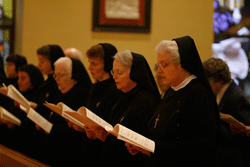Bishop Stika leads service to give thanks, celebrate those who practice evangelical counsels

DEVOTIONS TO A CONSECRATED LIFE Sister Mary Clara Auer, FSGM, right, is joined by Sisters Mary Christine Cremin, RSM, Mary Elizabeth Ann McCullough, RSM, Mary Timothea Elliott, RSM, Mary Sarah Macht, RSM, Mariana Koonce, RSM, and Mary Marta Abbott, RSM, during the Solemn Vespers service to recognize World Day for Consecrated Life Feb. 10 at Sacred Heart Cathedral. Photo by Dan McWilliams
The program for a Vespers at Sacred Heart Cathedral on Feb. 10 in commemoration of the World Day for Consecrated Life listed 10 orders of women religious and eight religious institutes and societies of men represented in the Diocese of Knoxville.
Bishop Richard F. Stika, who presided at the Vespers, likened Knoxville to his native St. Louis, known as the “Rome of the West” for all of the religious communities based there.
“Now as I look out among the community today, I think maybe Knoxville could be the new Rome of the West, for we are so blessed to have so many religious communities represented here in this small diocese of East Tennessee,” he said. “As I look upon the sisters and the brothers and the priests who minister to the good people of East Tennessee—some communities for a long time and some just recent arrivals—I see especially in my role as a bishop how lucky I feel that I am.”
About 25 sisters, one brother, and eight religious-order priests attended the Vespers, which also included exposition and benediction of the Blessed Sacrament. Orders and societies represented at the cathedral included the Dominican Sisters of the St. Cecilia Congregation in Nashville, the Missionary Congregation of the Evangelizing Sisters of Mary, the Religious Sisters of Mercy of Alma, Mich., the Sisters of Mercy of the Americas, the Apostles of Jesus, and the Paulist Fathers.
Each order listed in the Vespers program “had a founder that looked upon the Church and saw particular needs, not only in the Church but also in the community that surrounded them,” Bishop Stika said. “Needs that needed to be met by communities that serve Catholics and non-Catholics, Christians and non-Christians, the educated and those who are in need of education.”
Bishop Stika referred to the Diocese of Nashville’s founding bishop, Richard Pius Miles, OP, and “how he traveled far and wide building communities, small communities, throughout the entire state of Tennessee.” In conversations with Bishop David R. Choby of Nashville and Bishop J. Terry Steib, SVD, of Memphis, Bishop Stika said “we all agreed how easy we have it compared to what Bishop Miles put up with.”
“As we gather together this day, we give thanks for Bishop Miles and the bishops who have followed him and the religious men and women who have taught in the schools, who have nurtured those in need of healing, and who have stood as silent witnesses and sometimes not-so-silent witnesses about the values of consecrated life.”
The bishop said that Catholics should “always be good and wonderful signs of what consecrated life reminds us of: a willingness to share Gospel values with others.”
Bishop Stika concluded his homily by announcing that the diocese is in negotiations to relocate the monastery of the Handmaids of the Precious Blood, a contemplative order, to St. Thomas the Apostle Church in Lenoir City. Two sisters from the order, based in New Mexico, recently visited the diocese.
“If everything falls into place, and if it’s part of God’s plan, our diocese will be blessed to have a contemplative order, not only praying for the universal Church and the priests and religious but also praying for us, this small diocese in East Tennessee.”
The bishop ended by addressing “my sisters and brothers in religious life, consecrated men and women, in the name of all the good people which you are privileged to serve, people who are privileged to be served by you, please know of my affection and my gratitude and my prayers, for together we build the kingdom of God.”
The celebration of World Day for Consecrated Life began in 1997 when Blessed John Paul II instituted a day of prayer for women and men in consecrated life.
His intention was three-fold. First, he wanted to celebrate and give thanks to God for the gift of consecrated life to the Church.
Second, he wanted to promote the knowledge of and esteem for consecrated life by the entire people of God.
And third, he encouraged consecrated people to celebrate together, to rediscover the beauty of their way of life and “to acquire a more vivid consciousness of their irreplaceable mission in the Church and in the world” (Message for First World Day for Consecrated Life, 1997).
Consecrated life is a broad term encompassing all those men and women who practice the evangelical counsels of poverty, chastity and obedience.
These counsels configure people to Christ, who himself was poor, chaste and obedient. This life is a visible participation in the life of the Trinity. God the Father calls men and women to emulate the life of his Son, Jesus Christ, through the guidance and help of the Holy Spirit.
The ultimate goal of consecrated life is to direct the eyes of the faithful “towards the mystery of the Kingdom of God already at work in history, even as it awaits its full realization in heaven” (Vita Consecrata, 1).
